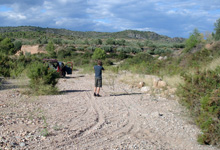Rio Palancia: hinterland to delta flux

Morphology, sedimentology, and radarstratigraphy of depositional sinks;
A system-oriented view of Pleistocene to Holocene watershed-scale sediment flux as controlled by long-term tectonic processes, climate change and human interference.
Research team
|
Geomorphology R. Hoinkis, P. Houben, J. Wunderlich |
Geophysics |
Geology R. Mediavilla López (IGME), J.I. Santisteban Navarro (UCM), G. Kowalczyk |
Cartography & data |
|
Financial support: This research project including 2 PhD positions is funded by the Deutsche Forschungsgemeinschaft (DFG). |
Motivation, objectivesThe current status of Mediterranean environments is like a palimpsest that is inherited from a continuous history of past environmental changes. The interaction of long-term tectonic movements, climate change and human impact control large-scale sediment detachment, delivery and deposition. Thereby, the environmental history of the Palancia catchment is characterized by severe impacts of human activities for 5000 years. So far, a wealth of research about soil degradation, and sediment fluxes from slopes to streams and to the coastal zone has been dedicated to the qualitative effects of human activities in Mediterranean catchments. However, data on the quantitative significance of human impact over time are still quite rare. There is also a need for studies that couple hinterland with coastal sediment flux and put the long-term processes of man-induced landscape change into a whole-watershed context. |
|
||
Approach and methodsIn order to gain new insights into quantities and timing of fluxes, long-term geomorphic effects, and non-linear and resilience system properties, our working goals focus on:
Publications Salat, C., Junge, A., 2010. Dielectric permittivity of fine-grained fractions of soil samples from eastern Spain at 200 MHz. Geophysics 75, J1-J9. Houben, P., Hoinkis, R., Santisteban, J.I., Salat, C., Mediavilla, R., 2011. Combining al-lostratigraphic and lithostratigraphic perspectives to compile subregional records of fluvial responsiveness: the case of the sustainably entrenching Palancia River water-shed (Mediterranean coast, NE Spain). Geomorphology, doi 10.1016/j.geomorph.2011.02.030.
|
|
||
|
|
Acknowledgment
We gratefully acknowledge the DFG for funding this project.






